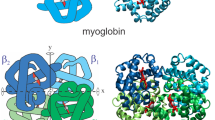Abstract.
The carboxylation and oxygenation processes of a model substrate, 3,4-dihydroxy-2-pentanone, have been theoreticaly characterized as a set of steps, mimicking the corresponding reactions of D-ribulose-1,5-bisphosphate catalyzed by rubisco. A theoretical characterization is carried out of transition-state structures and possible molecular intermediates represented as saddle points of index 1 and minimum energy structures, respectively. The quantum chemical characterization, at the HF/3-21G calculation level, of these stationary points is used to rationalize and to discuss both catalyzed sequences. The reported set of these stationary points maps out most experimental aspects of the reaction pathways for the real system.
Similar content being viewed by others
Author information
Authors and Affiliations
Additional information
Received: 24 March 1998 / Accepted: 3 September 1998 / Published online: 10 December 1998
Rights and permissions
About this article
Cite this article
Andrés, J., Oliva, M., Safont, V. et al. Transition-state structures for describing the enzyme-catalyzed mechanisms of rubisco. Theor Chem Acc 101, 234–240 (1999). https://doi.org/10.1007/s002140050435
Issue Date:
DOI: https://doi.org/10.1007/s002140050435




